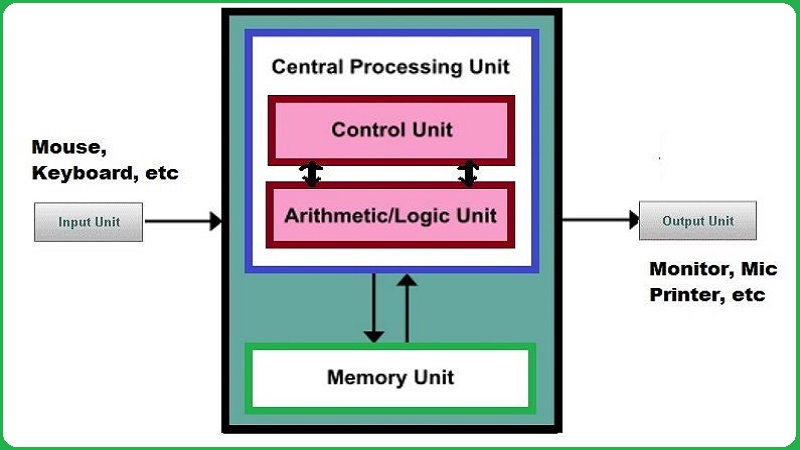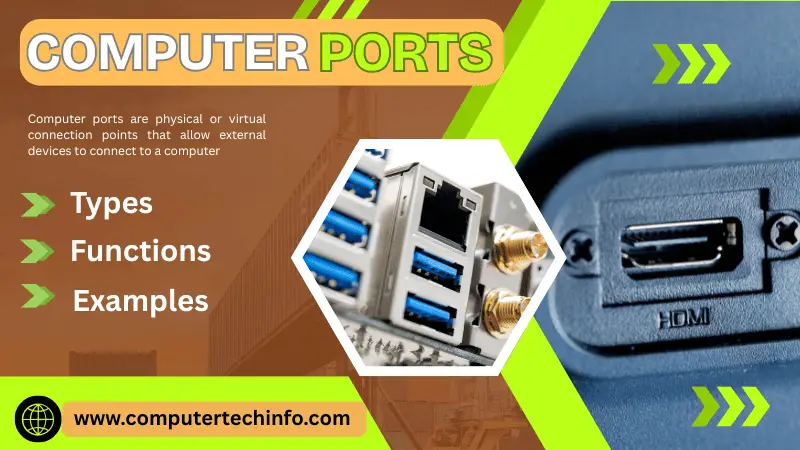Hi, friends! In this article, we will explain the block diagram of computer.
A block diagram of computer displays the internal structure of the computer, as we as the block diagram provides the quick overview of internal working work flow of computer system from inserting data to retrieving the desired output.

Block Diagram of Computer System
Computer system works with the combination of three components; like as –
- Input Unit
- Central Processing Unit
- ALU – Arithmetic Logic Unit
- CU – Control Unit
- Memory Unit
- Primary memory
- Secondary memory
- Output Unit
Computer Components with Their Functions
Input Unit
Input Unit contains the input devices like as scanner, joystick, keyboard, mouse, etc. These input devices allow to user for inserting the instruction or information into the computer system. Input unit plays the role as a mediator of communication that gets the data from user to the computer system for organized manner for processing.
Input Unit functions are
- The input unit helps to convert the inputted instructions into machine-readable (0’s and 1’s) for later processing.
- The Input Unit transfers the data to primary memory of computer system.
Central Processing Unit
CPU (Central Processing Unit) is an the “Brain” or “Heart” of the computer system. CPU is a hardware electronic device that is capable to perform various types of operations like as arithmetic and logical operation. It has ability to perform all calculations, comparisons or operations inside of the CPU.
CPU Functions are
- Fetch all instructions from memory
- Handle the sequence of all instruction
- To make communication in between all peripheral devices
- Handle the flow of all data and instructions from one component to other.
- To able to perform computation needed as per the application program.
Central Processing Unit has two segments like as arithmetic logic unit and control unit.
Arithmetic and Logic Unit
ALU (Arithmetic logic unit) has responsible to perform all arithmetic and logic operations, which data inserted via input devices, store in the main memory storage unit.
Arithmetical Unit can handle few simple operations like as addition, subtraction, division, and multiplication.
Logical Unit is capable to control the logical operations like as AND, OR, EQUAL, GREATER THAN, and LESS THAN, and so on.
Other operations like as comparing, selecting, matching, and merging data are also performed by Logical Unit.
Logical Unit is also able to perform Bit-shifting operations like as left shift , represents by the << operator and the right shift is represented by the >> operator.
Control Unit
The control unit (CU) deals to perform all activities and operations of computer inside the CPU. Control unit has a responsible to control input/output, memory, and other devices which linked to CPU.
Control unit obtains the set of instructions or information, then it helps to convert the instruction set to control signals, then these signals move to central processor for later processing. CU is able to understand which types of operations to execute with accurately.
The control signals are getting to help as per the prioritizing and scheduling the activates. It allows to make coordination all task inside computer in syn along with input and output units.
Control Unit Functions are
- It gives to instruct the input unit, where to save data, when input unit obtains it from the user through few input devices.
- Control unit can read one instruction at a time while executing of a program, and then it helps to execute all instruction at the ALU.
- The output of execution ALU delivers after the calculation is hand over to control unit that direct it move to memory and also to output unit for seeing the output on the screen.
Memory Unit
Memory unit also plays the major role in the computer system because it helps to store data and instructions before and after processing. This unit transfers the set of instructions to another unit of system as per the need.
Memory Unit is divided into two categories like as –
Primary Memory: Primary memory is known as “Main Memory” or “Internal Memory” or “Primary Storage Device” or “Internal Storage Device”. They play vital role in computer, because those memories are capable to access all data directly from CPU with the help of various buses. These memories have limited capacity for storage and made by integrated circuits (IC) or semiconductor components.
Primary storage devices are available in two variance such as volatile and non volatile. Volatile memory is an temporary memory because all data deleted when power get turn off mode but its access time and response time much fine to secondary memory. Non volatile memory is permanent memory in which nothing data erase when system is turn off.
Secondary Memory: Secondary Memory is also called “storage device” and “auxiliary memory“, “external memory“. These storage devices are volatile in nature, it means that data does not discard while power turn-off, in which all data store for long time.
Secondary memory has the speed of access of data is very slow compare to primary memory, and cheaper as well. Without primary memory, those secondary storage devices are useless because for processing the secondary memory must need the primary memory, first of all data are transferred into primary memory then these data make for executable.
Output Unit
The output unit of the computer system delivers the results of computation and displaying the output outside the world. The output unit generally works as the opposite process of the input unit and it convert the binary language digitized information to electronic impulses, which are readable to the output devices. There are few output devices, which are commonly using like as monitor, projector, headphone, speaker, etc.
Output unit provides the result into two forms like as soft copy or hard copy. The monitor is used for soft copy as displaying on the screen, whereas printer is used for hard copy as displaying on the paper.
Output Unit Functions are
- Output Unit receives the data or information into machine language from the primary memory of computer system.
- Output Unit helps to convert the machine language into human – understandable.



